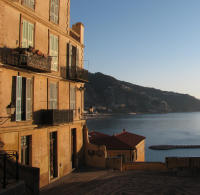
Menton, last stop before Italy on the French Riviera for gastronomy and art: on the one hand Mirazur, the restaurant of chef Mauro Colagreco, and on the other the Jean Cocteau Museum.
For some time now there have been whispers, rumors, developer dreams and political assurances that Menton may soon—one day—transition from a town (pop. 29,000) of serene and sunny comfort notable for its retiring well-being to a more sophisticated, more youthful, even luxurious destination.
Not that this fine-weather town is in need of upheaval—it’s main attraction as far as I’m concerned is that it offers some R&R from hyper-luxe, as they call it along the Riviera, though there is indeed much local wealth up in the hills. Menton simply wants some recognition that this isn’t where the French Riviera peters out before the Italian border but is rather one of its highlights.
If it is then that’s thanks in part to two markers of creativity and sophistication, the one gastronomic, the other artistic: Mirazur, the outstanding restaurant of chef Mauro Colagreco that overlooks Menton from the east, and the Jean Cocteau Museum, dedicated to a poet and artist who represents the artful high life along the French Riviera in the 1950s.

Mirazur – Mauro Colagreco
Looking out through the bay windows of Mirazur on a drizzly winter evening I could barely make out the lights along the coast below. But Mauro Colagreco’s resourceful, inspired contemporary Mediterranean cuisine sparks the imagination, and before long it wasn’t difficult to imagine sitting here on a long, dry spring evening enjoying the surprises of a blind tasting menu and watching the sunset on a sublime view of Menton and the sea.
Actually, we did have a tasting men, a group of journalists and me, after a wet day at Menton’s Lemon Festival.
Set on a hill along the French-Italian border, this soothing restaurant has an airy 50-seat upstairs (main floor) dining room and a 30-seat lower level dining area beside the windowed wall of the kitchen. There is also terrace and garden seating.
Mauro Colagreco, a chef-restaurateur from Argentina of Italian stock (all four of his grandparents were from Italy), has been the gastronomic draw of Menton since 2006. He was selected 2009 Chef of the Year by Gault-Millau, one of the most knowledgeable food publications in France. He has had a Michelin star since 2007. [Post note: In Feb. 2012, one month after publication of this article Mirazur received a second Michelin star.]
Basing his blind tasting menu on the day’s inspiration and produce, he elaborated for us a discovery dinner rich in variety and savors while clearly facing the sea and the coastal gardens.
As a wink to the lemon festival, a carpaccio of gascon (a Mediterranean fish) with a citrus vinaigrette and edible flowers. For a successful touch of audacity, cream of shallots with a puree of green apples and aquatic mint. For the pleasure of mixed textures, clams on an eggplant puree. For a taste of classicism, médallion de volaille served with candied lemon, which was the least remarkable dish of the evening, either because of its very classicism or because poultry doesn’t inspire the chef. Other than that fowl, the other half of the meal was equally expressive and true to the taste of the original ingredients.
Diners who don’t care for the risks and sensory overload of a tasting menu can rest assured that there are other options, though surprise is in any case a part of the game.
Service is smooth, pleasant. Among those attending to our table was a waiter on his first day at the job. Though as accommodating and personable as the others, he was either less apt at describing the ingredients of the dishes that arrived, which might be expected, or less willing to faking it, perhaps a bit of both. Toward the end of the meal, we asked him to show us a real Menton lemon. You see, Menton’s production of its celebrated lemon is about 10 tons while 120-140 tons of lemons and oranges are required for the festival, and those are imported from Spain. So we’d been ogling Spanish citrus all day and hadn’t much had the opportunity to get intimate with a real citron de Menton.
The waiter returned from the kitchen with a huge citrus. The tourist official sitting next to me remarked that it was quite large for a Menton lemon but was indeed the real deal.
Chef Mauro came out to greet and charm us after the meal. After some shop talk I asked if I could take his picture with the lemon.
“That’s not a lemon,” he said. “That’s a grapefruit.” Which goes to show that you can fool some of the people some of the time but you can fool journalists all of the time.
He was a good enough sport to allow me to take his picture with the grapefruit.
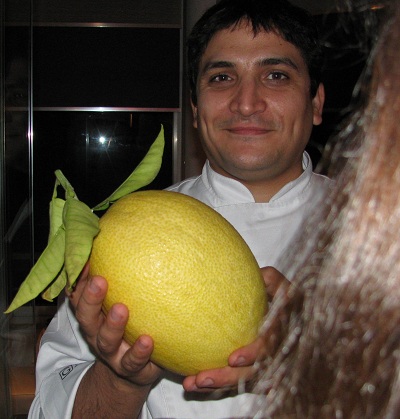
The hair that got in the way in the photo belongs to another journalist, because not only are journalists gullible but they will push you under a bus if you’re in the way of a shot that they want.
Here is Mr. Colagreco in a more dignified pose in his kitchen.
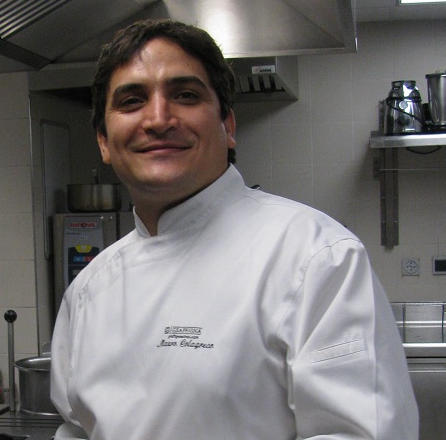
I was able to get a clear shot here after telling that other journalist that I’d just seen Carla Bruni Sarkozy out the window walking by on her way back from Italy.
Le Mirazur – Mauro Colagreco. 30 avenue Aristide Briand, 06500 Menton. Tel. 04 92 41 86 86. Open mid-Feb. to early November, Wed.-Sun. lunch and dinner, except from mid-July-end Aug. when open Tues.-Sun. for dinner, Sat. and Sun. for lunch.
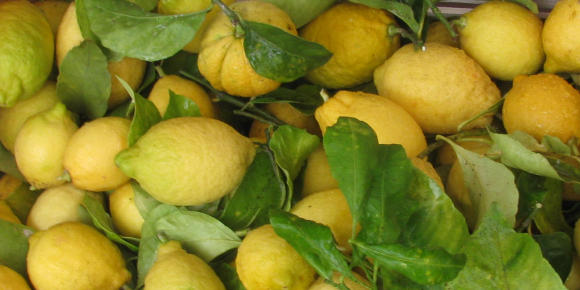
Jean Cocteau Museum
Like Pablo Picasso and Henri Matisse, Jean Cocteau remains heavily identified with the high and artful life along the French Riviera, particularly with respect to the 1950s in his case.
Cocteau (1889-1963) was a major figure in French art, theater and literary circles from the 1910s until his death in 1963, an artist’s artist of multiple talent—poet, novelist, playwright, graphic artist, filmmaker—flitting between genres and between friends in the worlds of art, theater and film.
Banking heavily on those talents, Menton has opened a major museum decided to Cocteau’s work and spirit throughout his career. The Musée Jean Cocteau adds a shot of modernism to the Old Town, both in its seafront architecture and in its exhibitions.
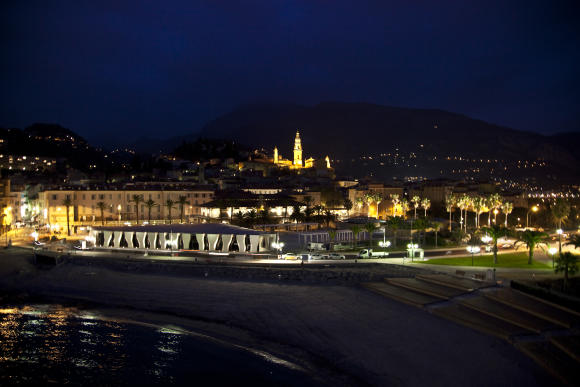
The museum is built around the donation of an enormous collection of Cocteau’s work from Severin Wunderman, who made his fortune in luxury watches. Born in Belgium, Wunderman’s family moved to the United States during WWII. He had previously displayed a part of his collection at a Cocteau museum that he created in Irvine, California in 1985. But the artist’s connection with the Riviera, a land where art, film, frivolity and wealth thrive, along with France’s reputation for subsidizing museums, made this the more appropriate home. Construction of the museum began shortly after Wunderman’s death in 2008.
In covering Cocteau’s output and his association with other artists, the museum displays in a given year only a portion of the vast collection, through both its permanent collection and its temporary exhibits.
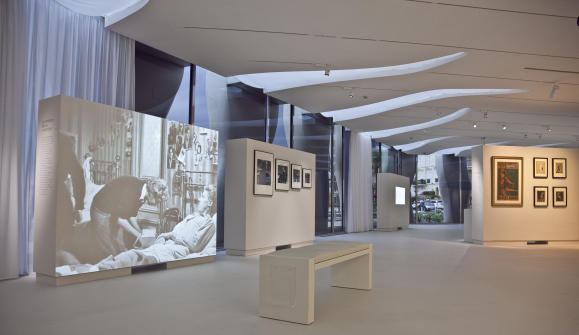
As poet first, graphic artist second, Cocteau’s visual and decorative graphics employed a style of playful, poetic arabesques of figures and motifs.
His decorative work can be seen in situ in the Marriage Hall (1957-1958) in Menton’s City Hall. He also designed the mosaics for the small 17th-century fort called Le Bastion that’s near the town’s port.
“Tattoos” is how Cocteau referred to frescos that he made while staying at a friend’s villa at Saint Jean Cap Ferrat, the exclusive-minded peninsula basking in the sea near Nice. Pretty graffiti or wall doodles may be another way of looking at some of his decorative work; through one eye they enliven white walls, through the other they await a new paint-job. The rooms he decorated at that villa, Villa Santo Sospir, are open to private visits by appointment only.
He also decorated the walls of the Chapelle Saint Pierre in Villefranche-sur-Mer, also near Nice.
Following in the footsteps of Jean Cocteau along the Riviera can get quickly tiresome for those who aren’t true fans, and I admit that I’m not. However, any of these glimpses, particularly the new museum, can serve as in insightful introduction to this man-for-all-arts, his work, and the marriage of art, wealth and leisure on the Côte d’Azur.
Musée Jean Cocteau, 2 quai Monléon, 06500 Menton. Open 10am-6pm. Closed Tuesday as well as Jan. 1 May 1, Nov. 1 and Dec. 25. In July and Aug. the museum is also open Friday until 10pm.
© 2012, Gary Lee Kraut


I have traveled mant times through France but never to the far corner of the Riviera. Thanks for the visit.